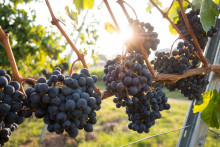ITC researcher Nina Schwarz is the project leader on behalf of the University of Twente. She explains the main idea behind SECBIVIT (Scenarios for providing multiple ecosystem services and biodiversity in viticultural landscapes).
'Viticultural landscapes are very appealing to us. They have a high cultural, economic and aesthetic value, but they also require an intensive form of agriculture. They need to be heavily managed. They wouldn't exist without humans, after all,' says Schwarz. 'Grape production often requires a lot of pesticides - and those can have a negative impact on biodiversity in the area.' Which is why the project focuses on pest management and possible reduction of pesticides.
Experiments in vineyards
SECBIVIT is working directly with and for wine growers, explains Schwarz. 'We aim to understand the implications of pest management in different countries. To achieve that, we are collaborating with local wine growers. Some of them will change the way they manage their vineyards, so that we can run various experiments. In the end, the knowledge we gain should serve as information mainly for wine growers in the involved countries, which represent the major European wine producers.'
project partners
- Austria: University of Natural Resources and Life Sciences
- Germany: Julius Kühn-Institute - Federal Research Centre for Cultivated Plants; University of Göttingen; University Koblenz-Landau
- Spain: Agencia Consejo Superior de Investigaciones Cientificas - CSIC
- France: French National Institute for Agricultural Research - INRA
- Romania: University of Agricultural Sciences and Veterinary Medicine Cluj-Napoca
- the United States: University of California
- the Netherlands: University of Twente
Farmers in a computer model
While some of the project partners will go directly into field to run measurements and collect samples in vineyards, ITC has a different role. The UT researchers will try to simulate the decision making of farmers - in a computer model. 'We will run simulations and see how the wine growers' decisions impact the grape production and the environment,' says Schwarz. 'What happens if, for example, there is a new policy or if new pests occur due to climate change? This way we can explore what the future of viticulture could look like.'
At the end of the three year project, SECBIVIT aims to come up with specific recommendations on pest management. 'I hope we can offer policy recommendations for the specific countries,' says the ITC scientist. 'I'm not sure if we can make one policy for the entire Europe. I really believe it needs to be adapted to the different landscapes and regions, because each country has specific environmental conditions, climate, culture and traditions.'
Natural enemies
Even though the research still needs to be carried out, as the project just started last month, is it possible to predict what these recommendations could include? What are the possible ways we might be able to reduce the use of pesticides? 'There are several methods that are being discussed,' answers Schwarz. 'Pests that feast on grapes can be reduced by their natural enemies. We could, for example, plant hedges that would nurture these natural enemies. However, it's also possible that the pests like the hedges as well. It's very difficult to nurture only the "good nature", which is why we will investigate various solutions directly in the vineyards.'







